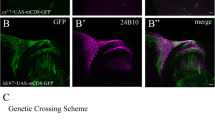Abstract
We previously cloned and characterized the Drosophila gene, tincar (tinc), which encodes a novel protein with eight putative transmembrane domains. Here, we have studied the expression pattern and functions of tinc during developmental processes. tinc mRNA is expressed in the central and peripheral nervous systems, and midgut during embryogenesis. In the third-instar larval eye disc, tinc mRNA is strongly expressed in all the differentiating ommatidial cells within and in the vicinity of the morphogenetic furrow. Loss-of-function analysis using the RNA-interference method revealed severe defects of eye morphogenesis during the late developmental stages. Our results suggested that tinc may have an indispensable role in the normal differentiation of ommatidial cells.





Similar content being viewed by others
References
Baumann O (2004) Spatial pattern of nonmuscle myosin-II distribution during the development of the Drosophila compound eye and implications for retinal morphogenesis. Dev Biol 269:519–533
Brand AH, Perrimon N (1993) Targeted gene expression as a means of altering cell fates and generating dominant phenotypes. Development 118:401–415
Campos-Ortega JA, Hartenstein V (1997) The embryonic development of Drosophila, 2nd edn. Springer, Berlin Heidelberg New York
Fan SS, Ready DF (1997) Glued participates in distinct microtubule-based activities in Drosophila eye development. Development 124:1497–1507
Hirota Y, Sawamoto K, Okano H (2002) tincar encodes a novel transmembrane protein expressed in the Tinman-expressing cardioblasts of Drosophila. Mech Dev 119:S279–S283
Kalidas S, Smith DP (2002) Novel genomic cDNA hybrids produce effective RNA interference in adult Drosophila. Neuron 33:177–184
Karagiosis SA, Ready DF (2004) Moesin contributes an essential structural role in Drosophila photoreceptor morphogenesis. Development 131:725–732
Kennerdell JR, Carthew RW (1998) Use of dsRNA-mediated genetic interference to demonstrate that frizzled and frizzled 2 act in the wingless pathway. Cell 95:1017–1026
Kennerdell JR, Carthew RW (2000) Heritable gene silencing in Drosophila using double-stranded RNA. Nat Biotechnol 18:896–898
Longley RL, Ready DF (1995) Integrins and the development of three-dimensional structure in the Drosophila compound eye. Dev Biol 171: 415–433
Nagaraj R, Canon J, Banerjee U (2002) Cell fate specification in the Drosophila eye. In: Moses K (ed) Drosophila eye development. Springer, Berlin Heidelberg New York, pp 73–88
Pili-Floury S, Leulier F, Takahashi K, Saigo K, Samain E, Ueda R, Lemaitre B (2004) In vivo RNA interference analysis reveals an unexpected role for GNBP1 in the defense against Gram-positive bacterial infection in Drosophila adults. J Biol Chem 279:12848–12853
Ready DF (2002) Drosophila compound eye morphogenesis: blind mechanical engineers? In: Moses K (ed) Drosophila eye development. Springer, Berlin Heidelberg New York, pp 191–204
Robinow S, White K (1991) Characterization and spatial distribution of the ELAV protein during Drosophila melanogaster development. J Neurobiol 22:443–461
Thomas GH, Zarnescu DC, Juedes AE, Bales MA, Londergan A, Korte CC, Kiehart DP (1998) Drosophila Heavy-spectrin is essential for development and contributes to specific cell fates in the eye. Development 125:2125–2134
Tomlinson A, Ready DF (1987a) Neuronal differentiation in the Drosophila ommatidium. Dev Biol 120:366–374
Tomlinson A, Ready DF (1987b) Cell fate in the Drosophila ommatidium. Dev Biol 123:264–275
Voas MG, Rebay I (2004) Signal integration during development: insights from the Drosophila eye. Dev Dyn 229:162–75
Wolff T, Ready DF (1991a) Cell death in normal and rough eye mutants of Drosophila. Development 113:825–839
Wolff T, Ready DF (1991b) The beginning of pattern formation in the Drosophila compound eye: the morphogenetic furrow and the second mitotic wave. Development 113:841–850
Wolff T, Ready DF (1993) Pattern formation in the Drosophila retina. In: Bate M, Martinez Arias A (eds) The development of Drosophila. Cold Spring Harbor Laboratory Press, Cold Spring Harbor, N.Y., pp 1277–1325
Acknowledgements
We are grateful to Y. Hiromi, the Developmental Studies Hybridoma Bank and the Bloomington Stock Center for providing us with the flies and antibody, and Toshie Naoi for technical support. This work was supported by grants from the Japan Science and Technology Agency, Ministry of Education, Science, Sports, Culture and Technology, and Ministry of Health, Labor and Welfare. Y.H. was supported by research fellowships from the Japan Society for the Promotion of Science.
Author information
Authors and Affiliations
Corresponding author
Additional information
Edited by C. Desplan
Rights and permissions
About this article
Cite this article
Hirota, Y., Sawamoto, K., Takahashi, K. et al. The transmembrane protein, Tincar, is involved in the development of the compound eye in Drosophila melanogaster. Dev Genes Evol 215, 90–96 (2005). https://doi.org/10.1007/s00427-004-0452-y
Received:
Accepted:
Published:
Issue Date:
DOI: https://doi.org/10.1007/s00427-004-0452-y




